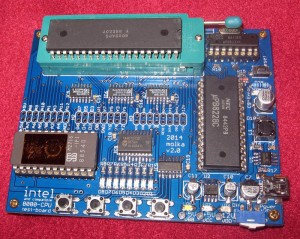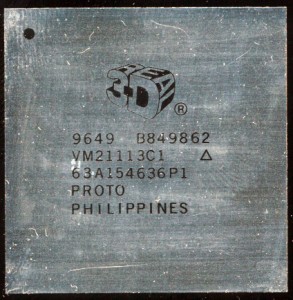November 25th, 2014 ~ by admin

MCS-80 testboard with included Tungsram 8080APC processor
The CPU Shack is excited to now offer MCS-80 test boards for sale and shipping now. These boards are intended to test Intel 8080A processors as well as their many compatible second sources and clones (such as AMD, NEC, Toshiba, and many more!
Each board runs off of a min-USB connector making it very easy to use. The 8080 processor is inserted into an easy to use ZIF socket making testing many different CPUs a snap. Included with each board is a working Tungsram 8080APC processor, an Intel copy made in Hungary.
Head on over to the MCS-80 page to buy yours today!
November 21st, 2014 ~ by admin
 The late 1960’s and early 1970’s saw the rise of the mini-computer. These computers were mini because they no longer took up an entire room. While not something you would stick on your desk at home, they did fit under the desk of many offices. Typically there were built with multiple large circuit boards and their processor was implemented with many MSI (medium scale integration) IC’s and/or straight TTL. TTL versions of the 1970’s often were designed around the 74181 4-bit ALU, from which 12, 16 or even 32-bit processor architectures could be built from. DEC, Wang, Data General, Honeywell, HP and many others made such systems.
The late 1960’s and early 1970’s saw the rise of the mini-computer. These computers were mini because they no longer took up an entire room. While not something you would stick on your desk at home, they did fit under the desk of many offices. Typically there were built with multiple large circuit boards and their processor was implemented with many MSI (medium scale integration) IC’s and/or straight TTL. TTL versions of the 1970’s often were designed around the 74181 4-bit ALU, from which 12, 16 or even 32-bit processor architectures could be built from. DEC, Wang, Data General, Honeywell, HP and many others made such systems.
By the mid-1970’s the semiconductor industry had advanced enough that many of these designs could now be implemented on a few chips, instead of a few boards, so the new race to make IC versions of previous mini-computers began. DEC implemented their PDP-11 architecture into a set of ICs known as the LSI-11. Other companies (such as GI) also made PDP-11 type IC’s. HP made custom ICs (such as the nano-processor) for their new computers, Wang did similar as well.
Data General was not to be left out. Data General was formed in 1968 by ex DEC employees whom tried to convince DEC of the merits of a 16-bit minicomputer. DEC at the time made the 12-bit PDP-8, but Edson de Castro, Henry Burkhardt III, and Richard Sogge thought 16-bits was better, and attainable. They were joined by Herbert Richman of Fairchild Semiconductor (which will become important later on.) The first minicomputer they made was the NOVA, which was, of course, a 16-bit design and used many MSI’s from Fairchild. As semiconductor technology improved so did the NOVA line, getting faster, simpler and cheaper, eventually moving to mainly TTL.
Read More »
November 15th, 2014 ~ by admin
Anandtech has an excellent article on the new Apple A8X processor that powers the iPad Air 2. This is an interesting processor for Apple, but perhaps more interesting is its use, and the reasoning for it. Like the A5X and A6X before it (there was no A7X) it is an upgrade/enhancement from the A8 it is based on. In the A5X the CPU was moved from a single core to a dual core and the GPU was increased from a dual core PowerVR SGX543MP2 to a quad-core PowerVR SGX543MP4. The A6X kept the same dual core CPU design as the A6 but went from a tri-core SGX543MP3 to a quad core SGX554MP4. Clock speeds were increased in the A5X and A6X over the A5 and A6 respectively.
The A8X continues on this track. The A8X adds a third CPU core, and doubles the GX6450 GPU cores to 8. This is interesting as Imagination Technologies (whom the GPUs are licensed from) doesn’t officially support or provide an octa-core GPU. Apple;s license with Imagination clearly allows customization though. This is similar to the ARM Architecture license that they have. They are not restricted to off the shelf ARM, or Imagination cores, they have free reign to design/customize the CPU and GPU cores. This type of licensing is more expensive, but it allows much greater flexibility.
This brings us to the why. The A8X is the processor the the newly released iPad Air 2, the previous iPad air ran an A7, which wasn’t a particularly bad processor. The iPad Air 2 has basically the same spec’s as the previous model, importantly the screen resolution is the same and no significantly processor intense features were added.
When Apple moved from the iPad 2 to the iPad (third gen) they doubled the pixel density, so it made sense for the A5X to have additional CPU and GPU cores to handle the significantly increased amount of processing for that screen. Moving from the A7 to the A8 in the iPad Air 2 would make clear sense from a battery life point of view as well, the new Air has a much smaller batter so battery life must be enhanced, which is something Apple worked very hard on with the A8. Moving to the A8X, as well as doubling the RAM though doesn’t tell us that Apple was only concerned about battery life (though surely the A8X can turn on/off cores as needed). Apple clearly felt that the iPad needed a significant performance boost as well, and by all reports the Air 2 is stunningly fast.
It does beg the question though? What else may Apple have in store for such a powerful SoC?
November 12th, 2014 ~ by admin

Comet 67P/Churyumov–Gerasimenko – Soon to have a pair of Harris RTX2010 Processors
In less then an hour (11/12/2014 @ approx 0835 GMT) 511,000,000 km from Earth the Philae lander of the Rosetta mission will detach and begin its decent to a comets surface. The orbiter is powered by a 1750A processor by Dynex (as we previously discussed). The lander is powered by two 8MHz Harris RTX2010 16-bit stack processors, again a design dating back to the 1980’s. These are used by the Philae CDMS (COmmand and Data Management System) to control all aspects of the lander.
All lander functions have to be pre programmed and executed by the CDMS with absolute fault tolerance as communications to Earth take over 28 minutes one way. The pair of RTX2010s run in a hot redundant set up, where one board (Data Processing Unit) runs as the primary, while the second monitors it, ready to take over if any anomaly is detected. The backup has been well tested as on each power cycle of Philae the backup computer has started, then handed control over to the primary. This technically is an anomaly, as the CDMS was not programmed to do so, but due to some unknown cause it is working in such a state. The fault tolerant programming handles such a situation gracefully and it will have no effect on Philae’s mission.
Why was the RTX2010 chosen? Simply put the RTX2010 is the lowest power budget processor available that is radiation hardened, and powerful enough to handle the complex landing procedure. Philae runs on batteries for the first phase of its mission (later it will switch to solar/back up batteries) so the power budget is critical. The RTX2010 is a Forth based stack processor which allows for very efficient coding, again useful for a low power budget.
Eight of the instruments are also powered by a RTX2010s, making 10 total (running at between 8-10MHz). The lander also includes an Analog Devices ADSP-21020 and a pair of 80C3x microcontrollers as well as multiple FPGAs.
November 3rd, 2014 ~ by admin

Real3D VM21113C1 Prototype (likely a Pro/1000)
Much of consumer tech starts life in the labs of defense companies. The reasons of course are simple, defense projects demand high tech, and are paid high prices by their respective governments. Usually this tech is eventually spun off or licensed to consumer companies. Occasionally, however, a defense company will commercialize a product on their own. Thus was the case of Real3D.
Real3D has its roots in GE Aerospace. GE needed to make simulators, with graphics good enough to be useful for training for a variety of systems. Their first system was a docking simulator for the Apollo Project in the 1960’s. By the 1980’s the technology had evolved into graphics systems for other simulators, notably the M1 Tank. This simulator used texture mapping graphics, which was in the world of sprites commonly used on PC’s was rather high tech. In 1992 GE sold the GE Aerospace division to Martin-Marietta who then merged with Lockheed. Lockheed Martin wanted to commercialize the graphics work GE Aerospace has developed and thus formed Real3D Inc. in 1995. Real3D’s first commercial success was the graphics work on the Sega Model 2 (Real3D/100) and 3 (Pro-1000) arcade systems. Real3D also began working with SGI and Intel on a PC based graphic solution to take advantage of the new AGP bus. This was known as the Starfighter, and later as the rather infamous Intel i740, its performance was not particularly good, but it was what Intel wanted for their entry into the value graphics market. Real3D also had the Pro-1000 whose performance was much better but it never made it out of the development stage.
In 1999 Lockheed closed Real3D and sold its assets (mainly IP) to Intel. The i740 was withdrawn from the market in 1999 as well, but its technology, and that of Real3D continued to be used by Intel in their integrated graphics chipsets (notably the i810 and i815), surviving still to this day. While no competitor to AMD/Nvidia Graphics it still is enough for most computing.




